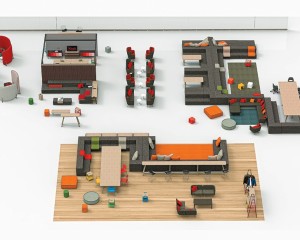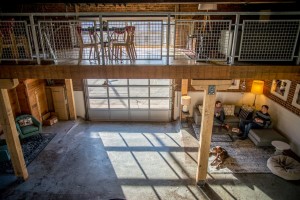A conference room is a busy place – every other employee wants to meet co-workers to discuss plans, brainstorm, come up with new ideas, flesh out ephemeral thoughts and keep getting productive. What happens when they can’t find the place to meet? What if somebody else is using the conference room for exactly the same purpose?
Ensue battle upon battle over who is going to be using the conference room when and next!
Says Sue ShellenBarger from The Wall Street Journal:
A mundane fixture of office life—the conference room—has become a flash point for tension and conflict.
Meetings are multiplying while private office space shrinks. Booking systems break down under dueling meetings. Employees reserve conference rooms far in advance—just in case they need them. Colleagues fume when a previous meeting drags on, leaving them standing in the hallway.
David Lewis sees the problem firsthand at employers he visits as a human-resources consultant. He and a client meeting to discuss sensitive personnel issues several months ago were exiled to Starbucks, after a conference room booked by his client was taken over by senior executives. Mr. Lewis and the client had to move again, to another coffee shop, when some of her co-workers arrived at Starbucks to hold a meeting of their own, says Mr. Lewis, president and chief executive of OperationsInc, Norwalk, Conn. “I had enough coffee to last a week just from that one meeting.”
Talking from personal experience, we are inclined to believe that is no exaggeration! Worse things have happened over conference rooms.
Shellenbarger continues;
Time spent in meetings has been rising by 8% to 10% annually since 2000, and is likely to continue increasing, says Michael Mankins, a partner in San Francisco with the management-consulting firm Bain & Co. Senior executives are spending an average 28 hours in meetings each week, and middle managers spend 21 hours, says Mr. Mankins, lead author of a recent 17-company time-management study with analytics provider VoloMetrix.
Meetings also consume too much space. An 11-firm survey by the architecture and design firm HOK found that conference rooms in general are too big: Some 73% of meetings involve only two to four people, but 53% of conference-room space is built for meetings of seven or more.
Truth be told, not all people use the conference room in the same way or always for the same purpose. It is then hard for different groups to coexist in a place they modify and define differently.
Rachel Bindl from National Business Furniture has some ideas to improve the collaboration between different teams or employees in using the conference room.
Have clearly defined conference room rules and etiquette
In order to dispel unneeded tensions and distractions, having a code of conduct for conference room usage can go a long way. It may feel a bit stilted, especially in a company with a more laid back culture, but it’s an effective method nonetheless. Ensure that everyone knows what the constraints are and how they are expected to act. This can be achieved through various means such as a company-wide email or a quick meeting detailing the issues and the new rules that will be put in place to solve them. For example, making it clear that meetings should not go over the reserved time can help people avoid clashes and also force more productive meetings. Constraints can be powerful motivators – knowing that they really only have a half hour to get everything done can keep people more on task during meetings.
Create more space for meetings
The most obvious way to solve this problem is to add more conference rooms. In some instances, this may be all that is needed. Perhaps there is an unused office that can easily be converted to a meeting space by adding the appropriate furniture items. Finding items in the right size for your room is absolutely vital. Feel free to read our Guide to Setting Up a Conference Room in order to ensure that the space will have everything that your workplace needs. However, we understand that for most businesses adding another conference room is not a simple prospect. Space comes at a premium and most of it is probably being used. If that’s the case, it’s time to think creatively about how you can use the space you currently have.
Think about the office building as a whole, not just your floor.
Many office buildings will have general conference rooms available for use. Some even offer these spaces free of charge – you simply have to sign up. Consider if this is an option for your company. There are also many furniture options that allow you to create separate office spaces. Using dividers and partitions allows you to section off a designated meeting space that teams can use when the other conference rooms are booked. Dividers don’t have to be boring either; LOFTwall creates incredibly stylish ways to divide and section off spaces.
Consider adding a collaborative functionality to the break room.
In most companies, the break room is occupied for only about two to three hours of the day. This means that for the other five to six hours, it stands almost completely empty. Outfitting your break room with multi-purpose furniture will allow teams to use the break room as a meeting space without disturbing anyone. Some such multi-functional furniture would include couches and adjustable height tables, like this option from Right Angle which does double duty as both a markerboard and working surface. With such products, employees can choose how to best use the furniture to suit their needs, whether collaborating or resting.
Part of a perfectly accessible conference room is the room design and furniture. Never underestimate the impact of a good conference table. Not all conference tables come with sets of matching chairs. Luckily, we can help you make the best matches.
To get you started, here’s an infographic outlining different (and innovative) conference room set-ups to help you manage meeting schedules a little better
 For help designing and furnishing the conference room at your workplace, visit Vision Office Interiors or call 320 203 2759
For help designing and furnishing the conference room at your workplace, visit Vision Office Interiors or call 320 203 2759


